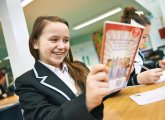Writing creatively on a theme linked to a text is a motivational and exciting prospect for teachers and students alike, and our students must be given an opportunity to be creative and to realise that their writing has real value. If pupils can write for themselves, and have their written words valued and respected, then they can start to begin the process of evaluating other texts.
Pupils often struggle with the concept of ‘analysing language’ or pinning down the elusive ‘effect of the word or phrase’ – usually ending up with the old expression, ‘the word is effective’. However, they might have little to no concept of what ‘effective’ actually means. If we teach students to write critically, where they actively choose the words they employ in their work, then we begin to demystify this term and make sense of what effective writing really is. This also improves pupils’ reading skills – and who knows, hopefully we will be inspiring the next generation of writers.
Many students are scared of ‘difficult’ vocabulary – but allowing them to experiment with words will support them in dispelling these fears and will allow them to develop their evaluative skills as they develop critical choice. Opening the lesson with an engaging clip or visual image related to the learning is always a great way in to the gateway of a child’s imagination. This is especially supportive for our non-readers and we should embrace the visual media to support pupils in developing their ideas. I have chosen a clip which links to the theme of Lord of the Flies as a dystopian novel and a way in to studying our literature text.
WHY TEACH THIS?
Teaching a novel to students is an opportunity to inspire our pupils with a love of reading so that they can journey through literature, and the literary experiences of the characters, in order to travel through life as well read and well rounded students who have a wider knowledge of the world. Using literature texts and their themes as a basis to develop pupils’ writing and to inspire great writing from our students is the essence of this lesson.
+KEY RESOURCE
Secondary schools and academies use the GCSE Achieve eLearning platform to identify and support learners’ skill gaps in English. The individual and independent approach provides an outstanding system of additional teaching and learning – supplementing lessons, structured homework and revision.
- Improve GCSE success rates & close the attainment gap.
- Satisfy funding & Ofsted requirements with data to show achievement and progression.
- Costs less than the standard funding rate for one Pupil Premium learner – for your entire school.
- GCSE Achieve is developed by bksb, one of the UK’s leading eLearning providers.
- GCSE maths is also covered.
For a free, no-obligation online trial visit www.bksb.co.uk/schools
STARTER ACTIVITY
Screening a melancholic clip from McCarthy’s ‘The Road’ (with or without sound) as a means into writing a descriptive piece about a dystopian vision of the world allows the students to think about what this really means – and of course, we want all of our young people to think hard within every lesson instead of writing down the key word ‘dystopia’ and its definition, which does not support deep learning.
Immersing students in the action of this clip, and asking them to imagine how they would present a vision of a dystopian world in their writing is the starter activity. Pupils can write down key words and or sentences from the clip and then feed back through class discussion about how the film creates a dystopian world and which words they would use to do this in their own writing.
MAIN ACTIVITIES
At this point in the lesson, you could introduce an extract from the text ‘Lord of the Flies’ and ask students to read this in pairs and highlight any negative images of the description of the island in the opening chapter (any dystopian novel opening could also be used, depending on your set text).
Alternatively, display a sentence, which delivers a description of the dystopian world from the clip, for example: “Gnarled and twisted, the old trees loomed over the beach. Decaying bark hung from their torsos like peeling wallpaper.” Ask the pupils to consider which individual words contribute to creating an overall impression of the setting – this can be modelled with the class on the board. Then ask students to suggest which words in the sentence do not fit this atmosphere. In this example, my class thought that the word ‘beach’ was too positive and settled on sand, shingle or island as being more fitting choices. They also came to the conclusion that ‘wallpaper’ called up a rather domestic image, and decided that ‘skin’ would be more disturbing. This rapidly evolved into ‘flesh’, at which point the class started to cringe – and all because of the choice of a single word. They had started to understand the effect and power of language.
Pupils then have to create effective sentences of their own which have a sinister atmosphere through using the images from the clip (have stills prepared so that students can refer back to these) and the extracts which they have read. Students can feed this back and the class can support, develop or challenge their ideas.
Finally, students should be invited to recreate a dystopian image of the world through their own writing. When pupils begin writing, ask them to craft each sentence slowly. Having sentence stems with multiple choices of words for the least able can support them in making an effective choice and producing something powerful. Learners must stop and read their work at check-points in the lesson to enable them to consider if their words choices have the desired atmosphere and effect before discussing this with a peer.
HOME LEARNING
Students can redraft their work based upon the feedback from their peers. They can create their own model of the dystopian world, which is labelled with key words from their creative piece of writing or re-write the opposite version of their description focusing upon a utopian vision of the world. Another suggestion is to ask students to work on a reading of their writing to deliver to the class.
SUMMARY
Get the students to read their work aloud and record the reading so that when they hear it back as an audio book they can be critical about the effect of the words used. Learners should be able to explain what a dystopian vision of the world would be like and to make a prediction about the text the class is going to read.
ABOUT OUR EXPERT
Laura McGlashan is acting deputy head, teaching and learning, at Burnt Mill Academy









